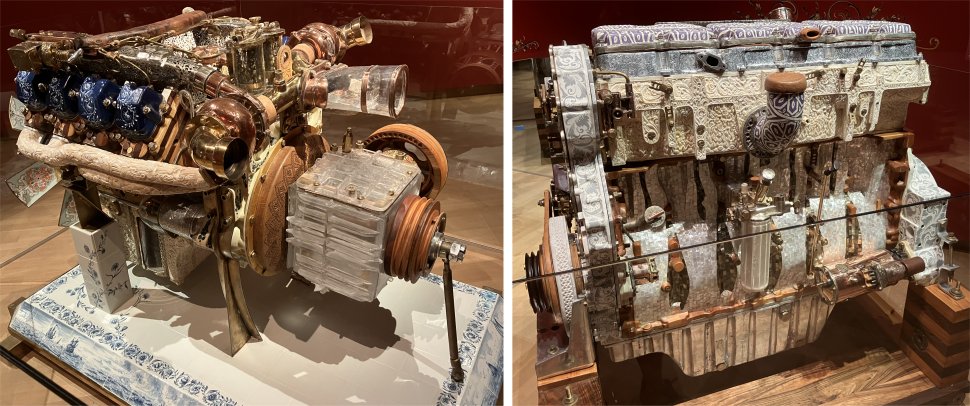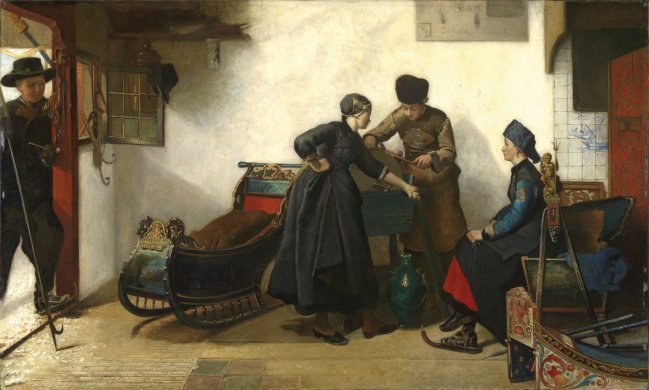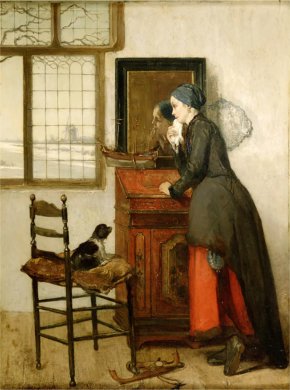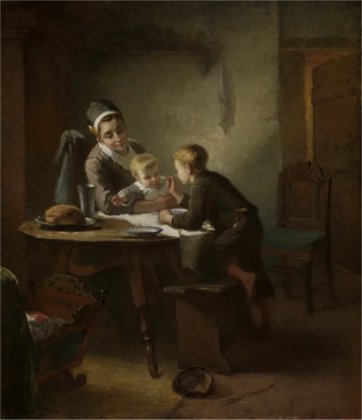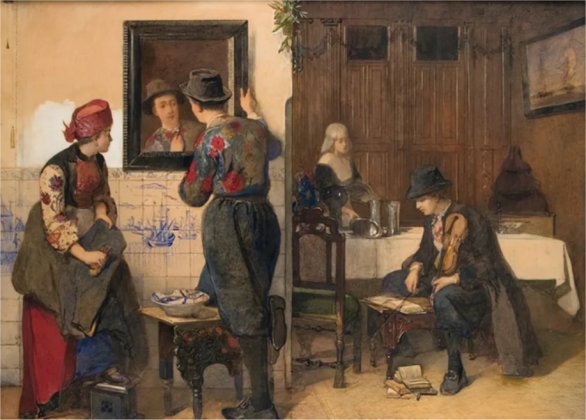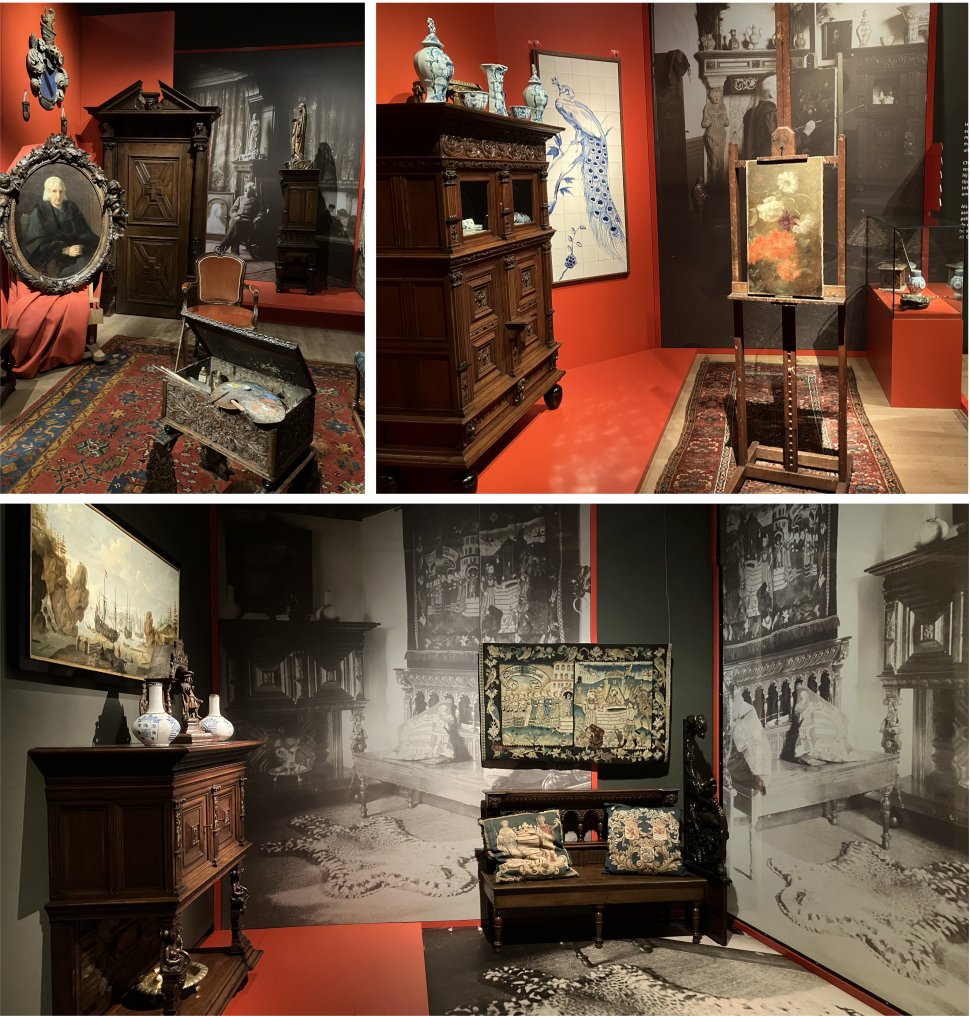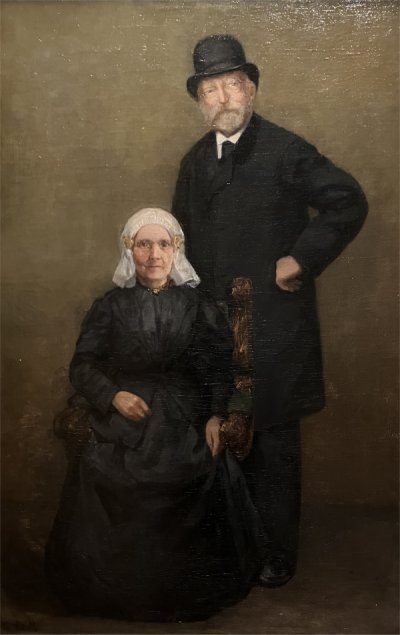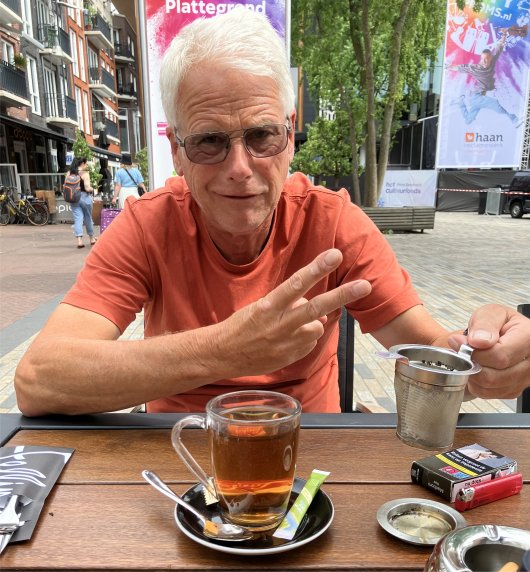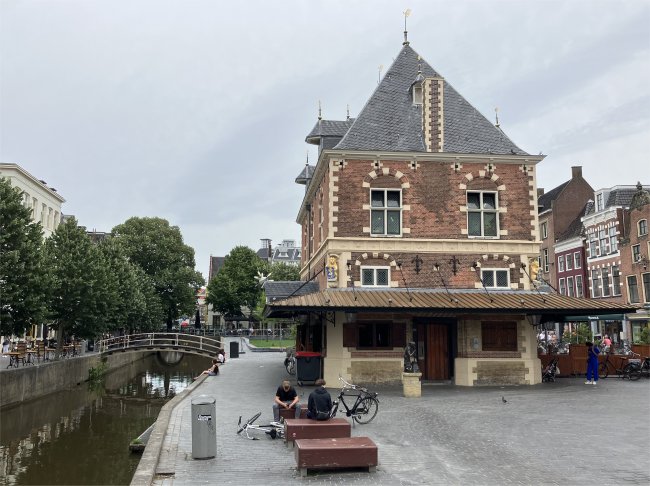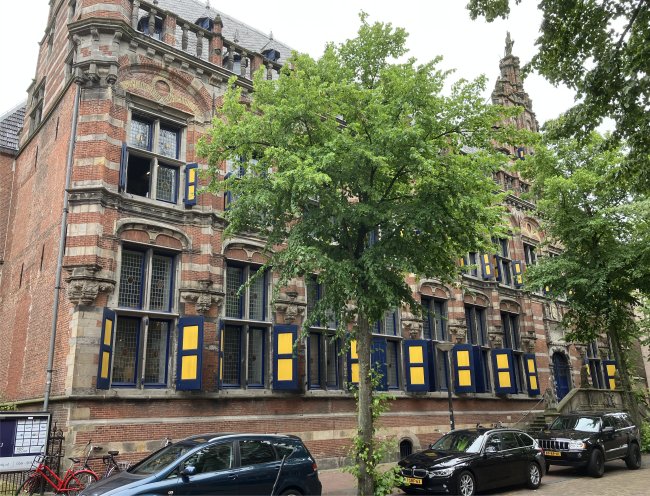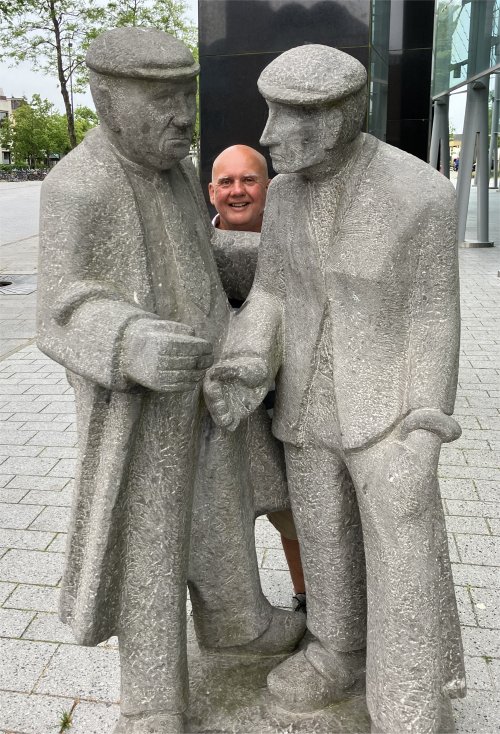A lady appeared on the next boat to us (I had met her husband the previous day after sorting out an electrical connection issue). She and her husband lived nearby within Harlingen. She enquired about our trip through Holland and our future plans.
The couple and their three children often ventured out on the waters and often visited the Frisian Islands. They only got three weeks holiday, so it was usually a mad dash here, there and everywhere, hardly pausing for breath. They had visited the East Anglian coast a few times, but time and money dictated their sailing activities. The woman was just switching their boat fridge on, so we left her to store the beers.
Rex and I headed down Zoutsloot (literally "salt ditch"). Its name was derived from the salt industry, important to Harlingen for many centuries. The salt was used for pickling meat, fish, and vegetables. Salt was also needed for dying fabrics from Harlingen's weaving mills. Most salt refineries were located in this neighbourhood. Street names, such as Westerkeetstraat, Oosterkeetstraat, Zoutsloot, and Zoutstraat, still refer to this past. There used to be a discharge channel on the seawall side of the Zoutsloot. The discovery of salt in Twente caused the salt industry in Harlingen to disappear. Incidentally, one of the punishments for criminals in Harlingen consisted of making them stand in a pickling barrel, a large container filled with salt water, for extended periods of time. The neighbourhood was considerably neglected in the first half of the 20th century, and many houses became decrepit. In 1964, the butter manufacturer Hein Buisman from Leeuwarden created the Hein Buisman Foundation. This foundation has since then restored many houses in Harlingen. The house at 43 Zoutsloot was the first house to be restored by the foundation.
The hike conveniently brought us to the train station where a train was ready to depart; time for a hasty ticket purchase. We whizzed through lush green fields, some populated with cattle and sheep, and all criss-crossed by grids of water drainage ditches.
Within 30 minutes were in Wilhelminaplein in Leeuwarden. The square had many cafes clinging along its sides. So, we took advantage, and chatted and people watched over coffee. At one end of the plain stood the Fries Museum, the main attraction of our visit to the city. Today, it was hidden behind a huge stage being set up for a forthcoming series of musical performances during 23rd - 27th June. Over the course of the next few days, a variety of musical performances were to be held over the town at various venues.
This university city is the capital of Friesland and one of the historical eleven cities. Leeuwarden developed out of three terp or hill settlements that originally stood on an expanse of water known as the Middelzee. These merged in 1435 and were granted a municipal charter. Thereafter the town grew into an important trading centre. With the silting up of the Middelzee, however, the town lost its harbour and became instead an agricultural market town and the chief centre of the Ostergos region. From 1524 to 1580 the town was the seat of the Habsburg Stadholder, who was succeeded from 1584 to 1747 by Stadholders of the Nassau-Dietz family. In the 16th-18th centuries Leeuwarden was famed for its fine gold and silverware. Nowadays Leeuwarden is a modern city with a mostly 16th century city centre, with many canals and city walls (the structure of the city walls looks like a diamond) and museums. The city has a laidback provincial air, its centre a haphazard blend of modern glass and traditional gabled terraces overlooking canals. It perhaps lacks the concentrated historic charm of many other Dutch cities, but it's an amiable old place.
Suitably refreshed, we circumnavigated the huge stage and entered the Fries Museum, a place I always look forward to visiting. A cheery young woman greeted us, sold us our tickets, and we immediately delved into the museum.
One of the reasons I really enjoy visiting this place for is it always seems so fresh and new each time. They have over 200,000 items, but can only display 1000 at a time, with two exhibitions in parallel. The museum has a policy of periodically changing over the displays so that items are not hidden away from public view in storage for decades. In addition, they loan items to other museums across the country, and in some cases donate items to other museums, enhancing their policy of making items available to the public instead of keeping then in storage. In addition, the museum also contains two or three temporary art exhibitions on show on display on the upper floors.
The lower floor was awash with a selection of paintings and artifacts depicting the province's history. Since I was last here, even more interactive screens had been added to the museum whereby the paintings and artifacts could be browsed, allowing the user to tunnel down for more information.
A lot of the objects had been buried centuries earlier in the mounds or terps. When people think of Friesland, they think of mounds. These man-made dwelling mounds protected Frisians from the unpredictable North Sea. From when they were first built in 600 BC, the mounds were made higher and wider until around 1000 AD. History was piled up in layers, and many objects ended up in the soil.
For centuries the mounds remained undisturbed, but around the year 1850 people realised that the fertile mound soil could be sold for good money. Over the next century, three-quarters of the mounds were excavated. Starting with the top, most recent layer, people burrowed their way into the distant past. Buried objects were exposed as the mound layers were removed. In fact, the mounds are actually Friesland's treasure chambers. An exhibition included a lacquer profile that demarcated the layers that make up a mound, and objects from different periods are used to show the history that the mounds conceal.
A film on show addressed the question of what makes Friesland Friesland? The borders that frame the province? Is it the language? Or the geological history of the current piece of land? The animated film took the viewer on a journey through time, from 10,000 years before Christ to the present day, showing how the landscape had changed geologically and geographically, how the boundaries between water and land have shifted over the centuries. Also included were maps of a more whimsical nature, which show contemporary interpretations of the Frisian country based on the language or the Frisians who live there. These show that Friesland can suddenly extend from Zeeland to Denmark.
| Hindeloopen Room (please use scroll bar) |
|
The famous Hindeloopen Room was still on display. The quirky town of Hindeloopen used to be a truly global city. In the 17th and 18th centuries the Hindeloopen sailors conducted extensive trade through Amsterdam with the countries around the Baltic Sea. At home their wives surrounded themselves with exotic luxuries. They combined colourful fabrics from India, China, Scandinavia and Amsterdam with gay abandon.
The best rooms in the captains' houses were decorated from floor to ceiling with Chinese porcelain, Indian fabrics with ornate floral motifs, Dutch furniture and wooden souvenirs from the Baltic region. But when trade collapsed at the end of the 18th century, outside influences ceased. The best rooms remained as they were and came to be known as "Typically Hindeloopen". These wonderful rooms were discovered by an international audience in the late 19th century. A mobile Hindeloopen Room caused a sensation at the 1878 World Exhibition in Paris. It was the first stop in an international tour. Suddenly Hindeloopen itself had become an export product. The Fries Verzetsmuseum (Fries Resistance) section told through individual stories, objects, photographs, film fragments and documents, moving and confrontational stories that invited contemplation about people who had to make difficult choices in trying times. In the exhibition visitors experienced how the Second World War was and still is experienced in Friesland. Eyewitnesses and objects with a personal story bring the war very close. Topics such as the air war over Friesland, the resistance against the occupying forces and going into hiding are central. Special attention is paid to the spectacular attack by the Frisian resistance on the Huis van Bewaring (House of Detention) in Leeuwarden.
It was during his stay in Morocco that he began to take a deep interest in all manner of engines. The Mercedes-240 is mostly used as a taxi in Morocco, where its German origin and reputation for quality and indestructibility have made the vehicle a status symbol. The Moroccan's ability to cannibalise old taxis in order to keep existing ones going fascinated him. Indeed, it is said that some taxis have done several million miles due to such recycling of engine parts. Van Hove built his Dorigin entirely from Mercedes-240 parts and drove it to its country of origin, where the car is seen more as Moroccan than as a typical German product. In this way, the work of art poses questions about identity and ownership. For the artist, the engine symbolises industrialisation, which in many countries marked the end of traditional craftsmanship. Production line work has replaced handcrafts. With his impressive replicas, Van Hove puts traditional crafts back on the map. He combines the beauty of design with current themes such as the distribution of wealth and the disparities between the West and the rest of the world. Glossy wood, shiny copper, polished mother of pearl: materials from all over the world are combined in the traditionally reproduced engines of Éric Van Hove. From the smallest screw to the cylinder head: international craftsmen handcraft each part under the direction of Van Hove. The highlight of the exhibition is the D9T, a reproduction of a Caterpillar D9 bulldozer engine. Initially this vehicle was designed for construction projects in developing countries. Since the Vietnam War, this bulldozer has often been used by regimes to suppress uprisings and riots and as barricades. Because of this, the bulldozer has come to symbolise oppression instead of construction. Van Hove's reproduction consists of 295 parts, made from 46 materials by 41 different craftsmen. The artwork consists of engraved cedar wood from the Atlas Mountains, carved purpleheart wood from Brazil, wenge wood from Congo and tatajuba wood from Suriname, as well as materials such as polished mother of pearl, bones, ceramics, marble, copper and tin. Another exhibition I came across that I had seen before, was titled "City Portraits" by Hans Wilschut. The eleven cities of Friesland, the Elfstedter, are a concept. Connected by water, they have formed the heart of Friesland for centuries. Heereneen and Drachten do not have any medieval town privileges, but they have grown into large cities. In the 17th century and especially in the 18th century, draughtsmen walked through Friesland and made drawings of views of towns, villages, streets and important buildings. The urban landscape was captured in this way until the invention of photography. Thanks to these drawings and paintings, we can now clearly see how the cities grew over time. The Museum of Friesland's commissioning of photographer Hans Wilschut to portray the towns of Friesland revisits this tradition. Wilschut photographs are a contemporary look at the thirteen Frisian cities of today. And he offers an unusual perspective; literally, because many of his photograph are taken from a higher elevation, and figuratively because that viewpoint he can pay particular attention to places of transformation. It is not the eye-catchers of the city that he photographs, but rather the places where the changes to the city can be seen. Another exhibition we came across covered the personal life and art of the Leeuwarden-born artist Christoffel Bisschop (1828-1904) and his English wife Kate Bisschop-Swift (1834-1928). This exhibition covered sources of inspiration, social environment and the work of contemporaries, and showed how the Frisian artist used the past as a great inspiration for the present. In particular, Bisschop became fascinated by the town of Hindeloopen.
One astonishing work of art I came across in the museum was a painting by Mondrian. Hearing the name Mondrian immediately conjures up images of straight lines, and blue, yellow and red colour fields. Yet the Fries Museum had acquired a different kind of work by Mondrian, an early painting that shows no trace of his famous abstraction. Indeed, at first sight it looked quite traditional. But there was something special going on in the portrait. In fact, when Mondrian depicted this couple, the husband had been dead for eight years. The painter had to use a photograph as an example, as is evident from the man's outer clothing. But the woman, too, tells a story with her clothes. In her familiar black jacket and Frisian widow's cap, she indicates she still feels Frisian after living in Amsterdam for years.
Suitably saturated, we retired to the Plein and indulged in a panini each, with Rex sipping Earl Grey tea with his, and me slurping ginger tea. Refreshed, we had a nostalgic stroll around the city starting with a walk up Nieuwstad, passing the Waag. A little detour took us to the Kanselarij, now part of the Fries Museum. The Chancellery for the Court of Friesland was built between 1566-71, and displays late-Gothic elements. The statue of Charles V, on the top gable, presides over the administrative, legal and military powers. The facade also has statues of the Seven Virtues and prosperity. Construction concurred with the beginning of the revolt against Spanish rule, resulting in financial shortages. As a result, a desired extension on the south side to ensure the symmetry of the building could not be realised. Several Renaissance style elements at the entrance already heralded a new era. The balcony with its double stairway and heavy parapet, decorated with the four quarters of the States of Friesland, dates from 1624. The Court was disbanded in 1795, after which the building was used as a law court, military hospital, barracks and prison. In 1895, it housed the Provincial Council Archives and the Provincial Library. In 1995, the building became part of the Fries Museum.
We now aimed in a westerly direction, passing Grote of Jacobijnerkerk with a class of school children playing in the playground outside the church, and weaved our way down Grote Kerkstraat until we reached the Oldehove, an unfinished brick church tower (1595-98) that was missing its top. It had been the beacon of Leeuwarden for centuries. Its height of about 40m was once considered extreme but is dwarfed nowadays by the office giants of Avero and Achmea at respectively 75m and 114m tall. The church to which the tower belonged was left unfinished because of the subsidence of the ground. To say that the tower is slightly off vertical is an understatement. The Oldehoofsterkerkhof square at the foot of the leaning tower Oldehove was being setup as another music venue.
We had been so absorbed by all this that we had forgotten time was moving on. We headed back to the station and caught a very packed-out train back to Harlingen. Once back in town, we headed to the Licht Boei. Sipping a beer outside, the landlady, who had given us a cheery welcome, came out and joined us. "You're not busy tonight," I said. "It is rather early, but it is always like this after a festival. There was music and all kinds of shows throughout the town. Usually, when we have a festival, the bar is quite quiet for a few days before and after the festival. I think people can't afford it for a while." A young fellow came by with his dog, with two pizza takeaways and two takeaway coffees. It was obvious the you man and landlady knew each other. "Ooi!" they shouted to each other, a Fries greeting. The landlady nipped into the bar, and returned with a biscuit for the dog. The dog looked at it, smelled it, and walked away in disgust, preferring the smell of the two pizzas.
"No, I'm from the very north west of England, near Scotland, hence the accent. The area is full of lakes and mountains," I informed them. "A group of us from the bar once visited Scotland," piped up the landlady. "It was wonderful, and it also had many mountains." "Where did you visit?" I asked. "Edinburgh," she told me, but couldn't remember the names of the other places. She tapped on one of the windows to summon a chap from within the bar. He appeared and she asked him where they had been in Scotland. "Edinburgh, the castle was great, Fort William and Inverness." That was all he could remember apart from the fact that they had visited a few distilleries. "We went on a coach trip one day up through the mountains, which we have none of in our country. Once we were passing through the tall mountain, all of us went quiet, it was quite mystical." Time was pressing, so we bade our farewells and headed to the Nooitgedacht once again; a favourite restaurant in this town. We were shown to our table by a pretty young waitress. "Are you Fries?" I asked. "No, but my boyfriend and his family are all Frisians. So now I work here." We dined well. Our quiet corner of the restaurant was then woken by around 17 young Germans arriving, who were then seated on two large tables adjacent to us. One of the waitresses explained the process to them in English, then two of the waitresses were almost constantly engaged in translating, taking orders and delivering food. They were indeed a noisy bunch, and appeared not to know each other too well. Perhaps they were all travelling on a tall ship we pondered. For dessert, Rex had a decaf coffee. I ordered a Jenever. "Young or old?" asked the waitress. "Old, please", I replied. Rex got his coffee, and we each received a glass that was continuously topped up by one of the senior waitresses. As we left, we booked again for the following evening. Back on board Duonita, we tried to crystalise plans for the next stage of our adventure. We needed to bear in mind we would have to cross back over the North Sea at some point, and Rex had to be back by the first week of July. We were alarmed at the weather predictions from a monitoring platform in the middle of the North Sea passage we would be taking back home. The next few days looked grim, Sunday was a possibility, and then the next low rolling in from the Atlantic was decidedly iffy for the rest of the following week. We could wait until the low had blown through and then make a dash, but we would have no guarantee the weather would settle. Besides, we'd go stir crazy if we remained couped up for too long. After a great deal of soul searching, we opted for a return over the North Sea on Sunday. Once committed to that, I called the restaurant and cancelled our booking. A quick check on tidal times in the Wadden Zee, and we decided to set off the following morning at 9am, our destination being Enkhuizen. |
|


